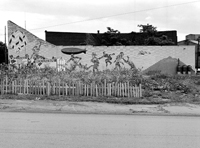MoMA PS1, the Museum of Modern Art’s plucky little sister in Queens (and the art world’s Ugly Betty), is brazen, strident and scruffy around the edges. It is more hip to trends and more idealistic; less jaded and less likely to be ladylike. Founded by Alanna Heiss in 1976 as a not-for-profit (and absorbed into MoMA in 2000), P.S.1 has focused from the outset entirely on contemporary art, which not only keeps the institution young but puts it in the thick of whatever passes, year-to-year, for the avant-garde. It is consistently redefined by the company it keeps.
Right now, that company is the roughly 70 artists and cooperatives in the group show “Greater New York 2010,” which opens Sunday. In 2000, seemingly in response to the Whitney Museum of American Art’s increasingly stale Biennials, P.S.1 launched its first Quintennial. The “Greater New York” title implies not only that the show (of art made during the past five years in the five boroughs and somewhat beyond) will stick close to home, but also that it will present us with a sampling of this city’s “greater,” as opposed to “lesser,” contemporary art. So far, “Greater New York” has yet to live up to the hype.
The “2010” installment, the series’s third, comprises painting, sculpture, installation, photography, video and performance art, as well as whole rooms devoted to the rehash of exhibitions and events since 2005. Covering all three floors as well as the boiler room, where the massive boilers have been covered in gold leaf as a backdrop for performances”2010″ is as much a zoo as its two predecessors. Maybe it’s the lingering schoolhouse energy of the Long Island City venue, or the youth and inexperience of the artists (most are in their late 20s or early 30s), but “Greater New York” has always felt a little bit chaotic and puerile. In “2010,” with so many artists in residence actually working in P.S.1’s galleries-cum-studios, it resembles a work in progress.
Organized by Klaus Biesenbach, Connie Butler and Neville Wakefield, the exhibition inspires its curators to venture beyond the decorum of midtown-Manhattan MoMA. Although “Greater New York” is nowhere near a cohesive or thematic show, artists have been grouped to create generally handsome galleries. The show feels professional even when the artwork doesn’t.
“Greater New York 2010” includes no painting or drawing of merit and little worthwhile sculpture. David Adamo’s “Untitled (rite of spring),” a floor made of Louisville Slugger baseball bats, is a surprise. So are Zipora Fried’s sculptures, of a table with dozens of bottles hanging below its top (they resemble metastasizing udders), and of an armoire, its back riddled with hundreds of butcher knives.
Standouts are the glamorous portrait photographs by Alice O’Malley, photos of urban landscapes and domestic interiors by LaToya Ruby Frazier, and grainy stills of exotic animals by Alisha Kerlin. Strong video installations include Tommy Hartung’s “The Ascent of Man,” a live-animation fairy tale exploring growth, metamorphosis and decay; Deville Cohen’s “Grayscale,” a ballet, in turns violent and comical, of fluttering ribbons and the sawing in half of a human brain; and Rashaad Newsome’s rap-video montage, a hypnotic, ritualistic and rhythmic dance of expressive hands.
Many works reflect the increasing obsession in contemporary art with themes, styles and things from the ’60s and ’70s. In “2010,” politics are less prevalent than in the past, but an interest in going “green” has spiked. And there is the age-old obsession with sex. The upside here is a resurgence of interest in the nude. The downside is that most of the nudes come from pornography either contemporary or vintage. And vintage is in. True, we are all, to some extent, enslaved by the period of our youth. But walking through the show is at times about as interesting as drifting through a local flea market.
“Greater New York 2010” is a messy, refreshing change from the Whitney’s 2010 Biennial. If the Biennials are an attempt to present us with a slice of the American zeitgeist, the P.S.1 Quintennials appear to have less lofty goals. And with MoMA P.S.1’s admission price at only $5, where else under one roof can you get so much contemporary-art bang for your buck?
But is it really worth it? The show presents only one narrow side of New York’s multidimensional art-world story. Youth-obsessed, its curators seem more interested in showcasing whatever the kids are doing than judging whether they are, in fact, doing anything worth showcasing at all. This approach tends to keep MoMA PS1 (and “Greater New York”) as a chronicler of contemporary art trends, rather than a museum proper whose function is not merely to present the “scene,” but to set the bar.

